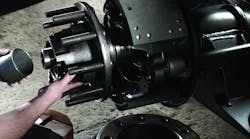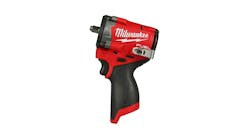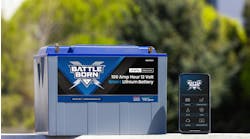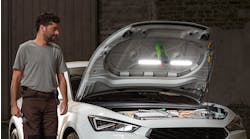A wheel hub assembly on a heavy duty truck has many moving parts, all critically connecting the wheels on the road to the rest of the truck. When something goes wrong with this system, it can be disastrous.
The good news is these situations are often preventable with proper inspection and appropriate maintenance practices.
It is important to first understand the basics of the wheel-end system, and how to identify the different types of wheel-end systems. Proper inspection – whether that be pre- and post-trip inspections or more in-depth service – is also critical to the continued performance of wheel-end systems.
End-play and preload
Some basic knowledge of wheel-end systems is required in order to understand proper servicing. In particular, bearing adjustment is critical to the safe and continued operation of the wheel-end system.
“There is not much room for error in bearing adjustments,” says Russ Kolany, heavy duty key account manager of bearing and seal manufacturer SKF. “Around the thickness of two human hairs is the margin.”
After installing the outer bearing and nut systems of the hub assembly, fleets should adjust wheel bearings in accordance with TMC RP 618, to ensure proper endplay measurement is within 0.001” and 0.005”.
“These clearances are critical to wheel-end health and are a key indicator of how the wheel-end is performing during inspection,” says Vincent Purvis, product manager - engineered products, Stemco. Stemco offers a range of wheel end components, braking and suspension products to the commercial vehicle industry.
Known as endplay, this measurement allows for slight degrees of clearance with the bearings – within one one-thousandth and five one-thousandths of an inch (0.001” and 0.005”). Technicians must use a dial indicator to accurately measure endplay.
“While this is the industry accepted range for manually adjusted wheel bearings, component manufacturers agree that the lower end of this range into slight ‘preload’ is the optimum range for wheel-end performance,” says Roger Maye, national service manager, Consolidated Metco Inc. (ConMet). “Preload is a condition that removes any excess ‘endplay’ in the bearing through a load or force being applied to the bearing, creating an axial interference.” ConMet supplies the commercial vehicle industry with wheel ends, aluminum castings and other components.
It is important to not have too much preload though, Maye adds.
“Too much preload can result in large amounts of heat being generated in the bearing, leading to damage and failure,” he says.
“Technicians with normal tools are not able to measure the amount of preload on the system,” Purvis explains.
All shops should have a calibrated torque wrench and dial indicator in order to complete this work on manually-adjusted wheel-ends.
In addition, there are specialty tools technicians can use that provide assistance with proper bearing and seal installation.
It is also important to follow bearing and adjustment procedures during wheel-end system installation, and also to incorporate regular inspection during PMs. It is recommended to record the endplay measurement as a requirement for every PM.
Pre-adjusted and unitized wheel-ends come from the factory calibrated with the proper amount of endplay. Manually-adjusted wheel-ends, on the other hand, require proper bearing adjustment any time the wheel-end is reinstalled on the vehicle.
Types of wheel-end systems
There are three types of wheel-end systems used on heavy duty trucks: manually-adjusted, pre-adjusted and unitized.
Sometimes referred to as traditional or conventional, manually-adjusted wheel-end systems are the most common in use today. These wheel-end systems have an adjustable fastening system and follow traditional methods for greasing and servicing. TMC Recommended Practice 618 provides detailed instructions for manual-adjusted wheel-end system installation procedures.
Pre-adjusted wheel-end systems provide a preset amount of preload during component assembly by the manufacturer. Pre-adjusted systems have “an aluminum hub with a spacer between the inner and outer bearings used to set a specific dimension for setting preload,” SKF’s Kolany says. The TMC RP 640 advises these wheel-end systems are typically field serviceable, but advises fleets should still refer to manufacturer’s service recommendations.
Unitized wheel-end systems go a step beyond pre-adjusted, in that the system includes bearings and seals installed, as well as lubricant, during component assembly at the manufacturing facility. It is a sealed unit, and care should be taken to follow the manufacturer’s service recommendations.
“Pre-adjusted and unitized wheel-end assemblies control their bearing adjustment through computer verification at the factory before the wheel-end is shipped to the end user, resulting in a wheel-end assembly that the operator only needs to torque the spindle nut to the proper installation torque to correctly install the wheel-end,” ConMet’s Maye explains.
Manually-adjustable wheel-ends require the most attention, due to the additional variables technicians are responsible for reviewing during the installation and maintenance process. Refer to TMC RP 640 for instructions on how to properly identify these systems.
It is important for technicians be able to identify the wheel-end system, to ensure proper maintenance procedures.
There are some key items to look for when identifying the wheel-end system, Maye says. First, look for the chassis decal or wheel-end identification on the hub cap, to confirm wheel-end type and lubrication specs. If this information is unavailable, the technician can disassemble the wheel-end to inspect the unit. Maye says many manually adjusted and some pre-adjusted wheel-ends will use a variety of different types of spindle nuts, and those nuts should include steps for proper installation.
The key indicator of a pre-adjusted wheel-end is the presence of a bearing spacer.
“If the wheel-end includes a bearing spacer, disregard the spindle nut installation instructions specific to manual bearing adjustment and follow the instructions from the manufacturer of the pre-adjusted wheel-end assembly,” Maye adds.
The wheel-end system type dictates the components replaced in the system during service. Rick Domin, Lead Technical Trainer for wheel hub and bearing supplier Timken, advises manually-adjusted wheel-ends require the replacement of cups and cones. For pre-adjusted wheel-ends, in addition to the cups and cones, the technician will need to replace the bearing spacer.
“If the technician removes the wheel-end and, after removing the retaining nut, notices the entire hub assembly must be removed and there is an inner and outer seal, they are most likely dealing with a unitized bearing and must replace them as a whole assembly,” Domin adds.
It is also important to evaluate the benefits of repairing versus replacing the wheel-end unit. As is the case with aged or high-mileage vehicles, the hub casting, bearings or bolts may be severely worn or damaged.
“Many times a technician is not properly trained to determine if these components are suitable for re-use,” Maye advises . “When the cost of components to rebuild the wheel-end, the labor involved, the additional time out of service for the vehicle and the liability for the repair is considered, wheel-end replacement is often the best option. The new wheel-end can be quickly installed and often times comes with an extended warranty. The new assembly will put the wheel-end back to as new condition.”
Importance of proper lubrication
“The three critical components for wheel-end performance are bearings, lubricant and the seal,” explains Stemco’s Purvis. “TMC’s recommended lubricant practices show that lubricant condition is a leading indicator of wheel-end health.”
Lubricant leakage is symptomatic of a larger issue – primarily due to seal failure because of improper wheel bearing adjustment. This goes back to the importance of measuring proper endplay.
When it comes to lubricants, there are two types of lubrication processes for traditional wheel-end systems – oil bath wheel-ends and semi-fluid grease wheel-ends.
It is important to review information from the manufacturer on the process for lubricating pre-adjusted and unitized hub assemblies.
While it is the fleet’s decision on what type of lubricant to use, TMC and manufacturers have suggestions on how to select the right lubricant for the intended application.
- Lubricants should be specified for use on wheel-ends.
- Oil (synthetic or mineral) – must meet SAE J2360 requirements or API GL-5/MT-1 guidelines. Example lubricant weights, per Stemco, include 75W-90, 80W-90; 80W-140, 85W-140.
- Grease (semi-fluid) – The minimum operating temperature range should be within -20 degrees F to 325 degrees F.
When considering lubricants for manually adjusted wheel-ends, either synthetic- or petroleum-based oils or greases are acceptable to use. First, note if the wheel-end is part of a driven or non-driven hub assembly. Different non-driven wheel-ends include steer, dolly, trailer, pusher and tag axles. According to TMC’s Recommended Practice 631, fleets can lubricate non-driven wheel-ends with their preference of oil or grease. For drive axles, however, only oil is recommended.
Differences in lubrication types and performance standards for axles mean different suggestions for maintenance (see sidebar "Pre- and post-trip checklist for wheel-ends").
Service interval ranges from 100,000 miles to five years in over-the-road service, depending on the axle type, manufacturer recommendations and lubricant performance capabilities.
“Consult with your vehicle, wheel-end and lubricant manufacturers to determine the lubricant that is best for your particular application,” ConMet’s Maye advises.
When inspecting lubrication for wheel-ends, Maye also says inspection should note the level and condition of the lubricant.
Proper wheel-end installation and maintenance
It is important to address improper wheel-end installation, unit contamination, overloading or lubrication issues.
Taking into consideration the integral aspects of identifying and servicing wheel-end systems mentioned earlier, fleets can be sure to properly implement maintenance programs to service this area of the vehicle.
In addition to verifying proper endplay, fleets should note proper wheel nut (including axle nut, spindle nut, lug nut, etc.) torque measurements. Whether under- or over-torqued, improper torqueing accounts for many wheel-end failures.
Inadequate torque can cause the wheel bearings to fail – the most common cause of wheel-end failures, says SKF’s Kolany. This is due to the loss of clamping force on the lug nuts, or amount of pressure applied to keep the wheel and hub intact.
Conversely, excessive torque can cause additional stress on components by causing stretching and fracturing of the lug nut stud.
“If a lug stud is broken or missing, the damaged lug stud should be replaced along with the two studs on either side the broken stud,” Kolany says. “If more than one stud is broken or missing, all lug studs should be replaced on the hub. Lug nuts should be cleaned and attached.”
In addition, Kolany notes the washer should spin freely on the nut. If it doesn’t, he advises to replace the lug nut stud.
Jamie Untersinger, Business Development Manager, Vehicle Inspection Systems, recommends the “R.I.S.T.” checklist for the removal and replacement of wheels, to help reduce the chance of a wheel-off situation:
- Remove the lug nuts and wheels.
- Inspect the studs for stretching, nuts for stripped threads, and wheels damage and cracking.
- Snug the lugs.
- Torque the wheel bolts using the desired torque pattern and correct lb-ft.
Vehicle Inspection Systems promotes brake and undercarriage inspection as well as wheel and rim safety products for the commercial vehicle industry.
What to review during inspections
Whether it's pre-and post-trip inspections by drivers, or assessing the wheel-end system as part of regular preventative maintenance, visual checks can provide warning signs to issues. Fleets should look for any broken or damaged components, and for any leakage around seals and hub cap gaskets. Depending on the type of lubrication method, Stemco’s Purvis recommends inspecting the hub for the following:
- For oil bath wheel-ends: Visually inspect, using the hub cap window, to verify proper oil fill level and lubricant integrity.
- For semi-fluid grease wheel-ends: Look for any significant variation in hub temperatures upon in-service inspections, accounting for seasonal temperature influences.
For pre-and post-trip inspections, “the lubricant levels are easy to check,” Timken’s Domin confirms. “Additionally, look for wetness on the back of the wheel which could indicate a seal leak.”
“When performing a wheel-end inspection, the technician should check the wheel bearing seal for signs of excessive leakage, the hub assembly for excessive endplay and the hubcap or axle flange for signs of lubricant indicating a leaking gasket or possible damage to the hubcap,” Domin adds.
SKF’s Kolany says it is critical to have drivers properly trained to inspect wheel-ends. In addition to educating drivers on proper techniques on confirming possible lubricant leakage, they can visually inspect for slipping or missing lug nuts and other aspects of the unit.
“If the lug nuts are loose or backing off you will notice rusty discoloration or lines as if they’re slung from the wheel bolt area,” Vehicle Inspection Systems’ Untersinger adds. “This is a good indication torque should be rechecked immediately.”
Drivers should also physically touch the wheel-end assembly during a post-trip inspection to confirm heat generated from the unit.
“Warm to touch is normal but when too hot to touch, there is a problem” Kolany says.
Regarding operating temperature, it is recommended the wheel-end temperature record at no higher than ambient temperature-plus-150 degrees F. In other words, if it is 50 degrees outside, the temperature should not exceed 200 degrees F.
“Heavy braking or a dragging brake can also effect wheel-end operating temperature,” ConMet’s Maye says.
High temperatures can be indicative of a more widespread problem with other areas of the vehicle like the braking system.
“Overheated brakes can cause excessive heat to the wheel hub that can damage the seal and cause the seal to leak lubricant onto the brake shoes,” Domin says. “In such instances, the brakes will be less effective and cause increased stopping distances, which will in turn apply more heat to the wheel-end and cause more seal damage.”
Other indirect causes of bearing adjust issues or failures, as it relates to wheel-ends, include premature leaking seals, ABS fault codes and abnormal brake wear.
When techs conduct inspections in the shop, they have access to additional tools for conducting PMs.
“TMC RP 631, 651, and 655 provide an excellent starting point for determining the PM schedule that fits your fleet,” Maye advises. “Your actual inspection program should be based on your own fleet performance history and will be different based on equipment specifications and application.”
Maye provides the following suggestions for PM schedules, dependent on the needs of the fleet:
- Every month, visually inspect back of hubs and hubcaps for seal or gasket damage and leakage.
- Every three months, follow steps above for monthly inspection. In addition, check by touch for roughness of wheel spinning, or for excessive endplay.
- Every twelve months, remove and disassemble hub assemblies. Clean and inspect all components and replace as necessary. Replace seals and repack bearings with fresh lubricant.
When a complete teardown is required, Kolany suggests the following: “Wheel hubs, wheels, lug nuts, lug studs and center pilots should be cleaned, inspected and wire brushed during removal. Inspect hubs and wheels for any cracking, missing or loose lug studs along with checking for excessive end play in the wheel bearings.”
Once reinstalling the wheel-end unit, it is critical to follow proper torque specs for stud nuts, proper measurement for endplay, and proper lubrication levels. Once the unit is back on the vehicle, “final inspection after installation should be a road test of vehicle and then a recheck of torque,” he adds.
Training and next steps
Training is integral to proper installation and maintenance of wheel-end systems. Many manufacturers can provide wheel-end installation training to technicians. Additional training and certification is also available through the Tire Industry Association (TIA).
“The best prevention is proper training for technicians so that they can properly identify the type of wheel-end being worked on, and know how to service each system correctly, including knowing the proper procedure for manual adjustment and knowing what components to use for proper installation of pre adjusted systems,” Timken’s Domin says.
With regular inspection and proper maintenance, many wheel-off situations are preventable. Inspecting and detecting wheel-end conditions is less time-consuming and more efficient in the long run to preventing damage.




